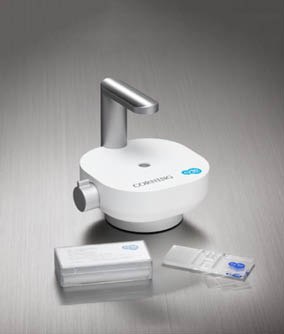Corning® Automated Cell Counters: Open vs. Closed Systems
Manual cell counting is often time-consuming and prone to error, particularly if the researcher is dealing with large numbers of samples. Human perception of cell definition as well as dilution and pipetting errors are common pitfalls in manual cell counting. Although manual counting provides an initially lower start-up cost, the time spent counting the cells, as well as the errors made in the process, can give rise to greater long-term labor-associated costs.
Automated cell counters offer an alternative to manual cell counting, providing a greater level of precision and accuracy in counting results. Practically all automated cell counters are closed systems, which provides some level of protection from environmental influences that can affect the final analysis. Open systems, however, may have greater flexibility and utility in research. Open automated cell counting systems, such as the Corning® Cell Counter, may provide greater durability, higher efficiency, and potentially fewer long-term costs during cell culture research. In order to determine the best automated cell counter strategy, a potential operator must understand the advantages of both a closed and an open system.
Advantages of Open Cell Counters
The time savings associated with an open automated cell counter potentially translates into a more cost-efficient experiment. Advantages include having the ability to view larger areas of the counting chamber as well as requiring fewer or no disposables.
The Corning® Cell Counter is the only automated cell counter at present that is completely open. This type of system allows the researcher to move throughout the counting chamber more fully, while enabling easier quantification of multiple different cell areas. Thus, the expanded analysis of a larger area allows for higher accuracy compared with a closed device.
Instead of using only specific parts of a counting chamber, an open system allows for a more complete analysis of the entire counting grid. Open systems also do not require disposables and can be used with any standard hemocytometer, reducing the need to purchase additional tools and materials. Therefore, an open system is more cost-efficient than a closed system.
Advantages of a Closed System
Despite the potential cost-related disadvantage, closed systems may provide extra protection from outside influences, such as cells from nearby solutions, viruses, or bacteria that may accidently enter the system. The potential risk of outside contamination can vary greatly depending upon laboratory conditions. Open systems are also more prone to medium loss, whereas a closed system helps contain the medium and reduces the likelihood of contamination.
Contamination of the cell sample may lead to incorrect visualization of the cells, subsequently causing cell counting errors. Also, some closed system cell counters feature an additional module that requires the use of fluorescence, a feature not typically present in open system cell counters. Fluorescence aids in the visualization of cells and allows for a clear view of cell numbers.

Corning® Cell Counter
Open vs. Closed Cell Counters
Aside from the Corning® Cell Counter, almost all automated cell counters on the market are closed systems. Closed systems usually require disposables, which can increase costs associated with an experiment.
Thus, a closed automated cell counter may not always be as cost-effective when compared to open systems or even manual counting. Still, closed systems are perhaps one of the most widely utilized types of automated cell counters where accurate and precise cell counting is essential.
Corning® Cell Counter: An Open System Automated Cell Counter
The Corning® Cell Counter system performs a single measurement faster than other automated cell counters and can analyze images faster than traditional automated counters. In fact, this cell visualization and counting device can provide a single measurement in less than two seconds, depending upon the type of computer used during the imaging process.
In keeping with its open system feature, the Corning® Cell Counter allows the operator to move the counting chamber, facilitating the counting of multiple areas. Additionally, this system uses the full counting grid and enables a larger field of view, which provides a more accurate result in the total cell count of a sample.
As an automated cell counter, the Corning® Cell Counter will calculate the average cell concentration, median, standard deviation, and will display the images of the counted cells quickly and accurately.
This quick turnaround time allows operators to channel a greater proportion of their time toward more important experimental tasks.
Materials
To continue reading please sign in or create an account.
Don't Have An Account?